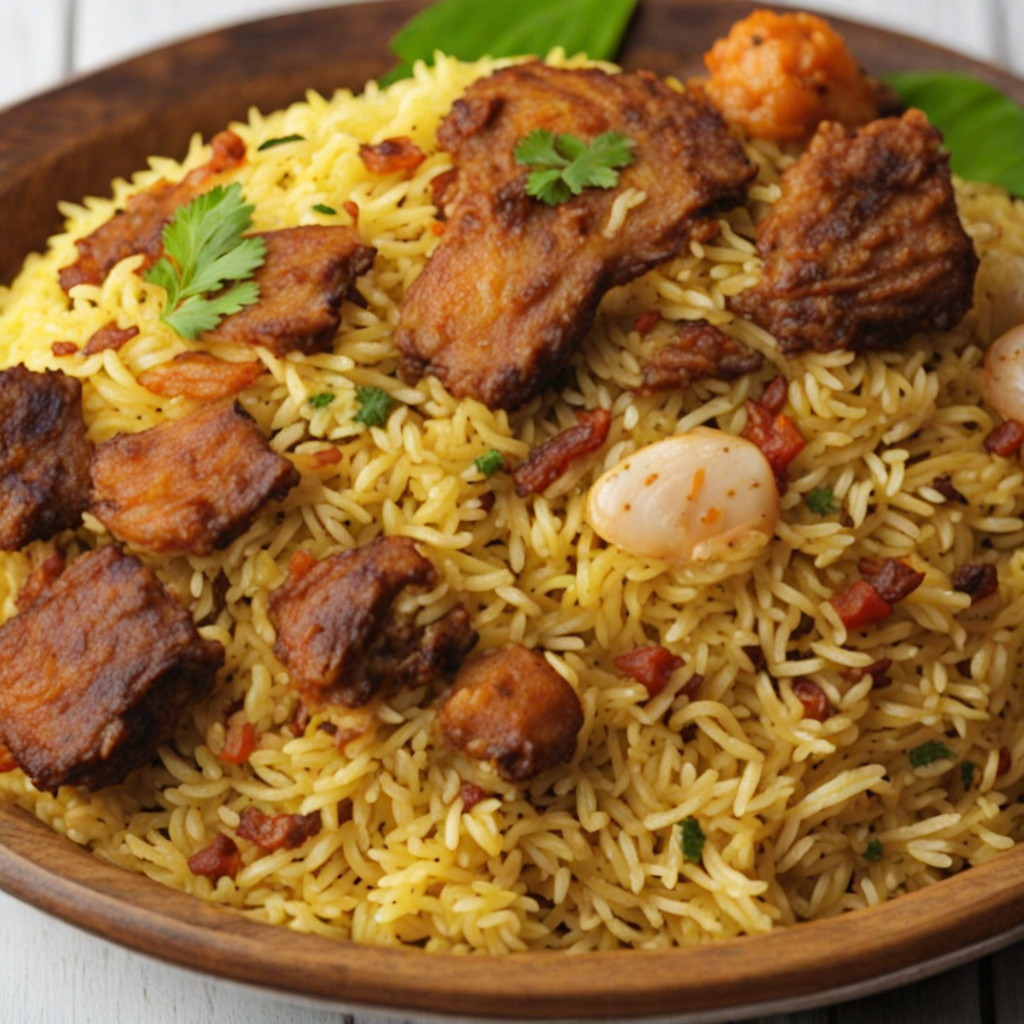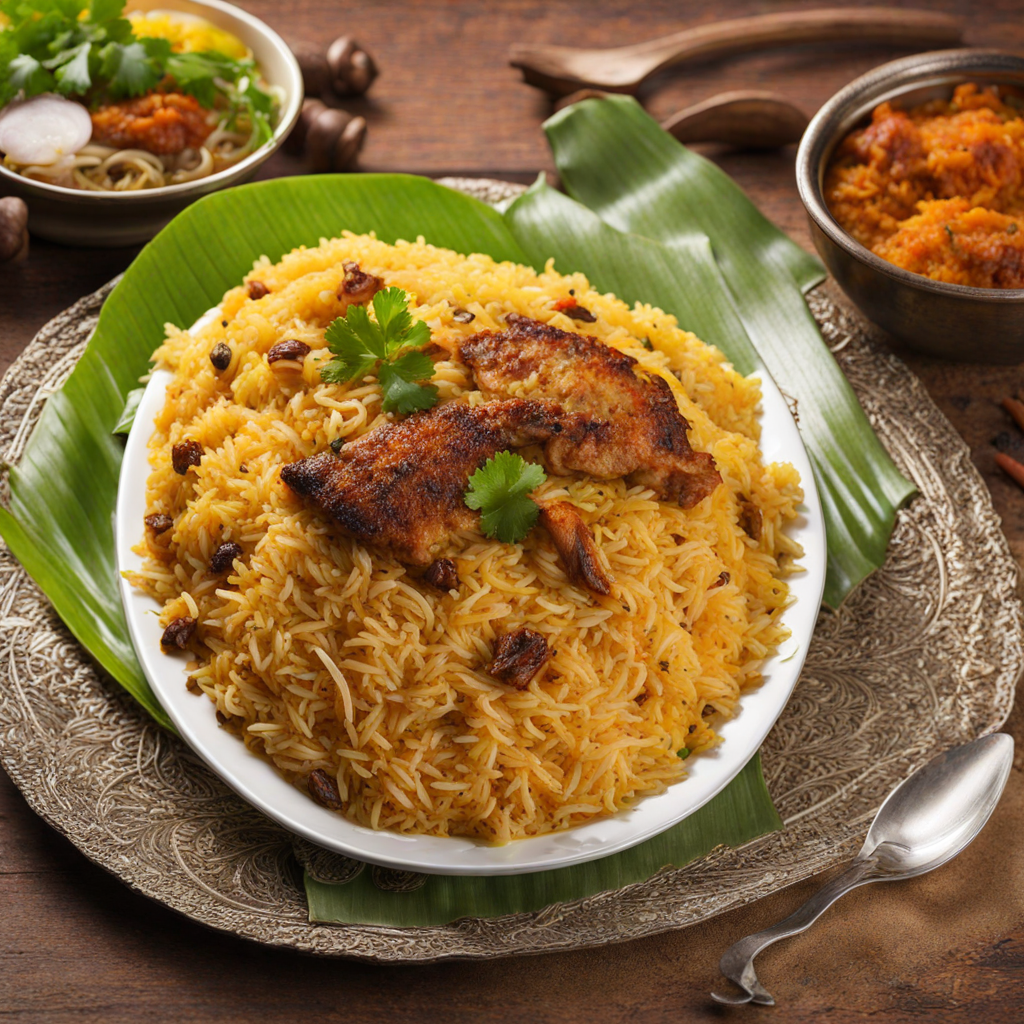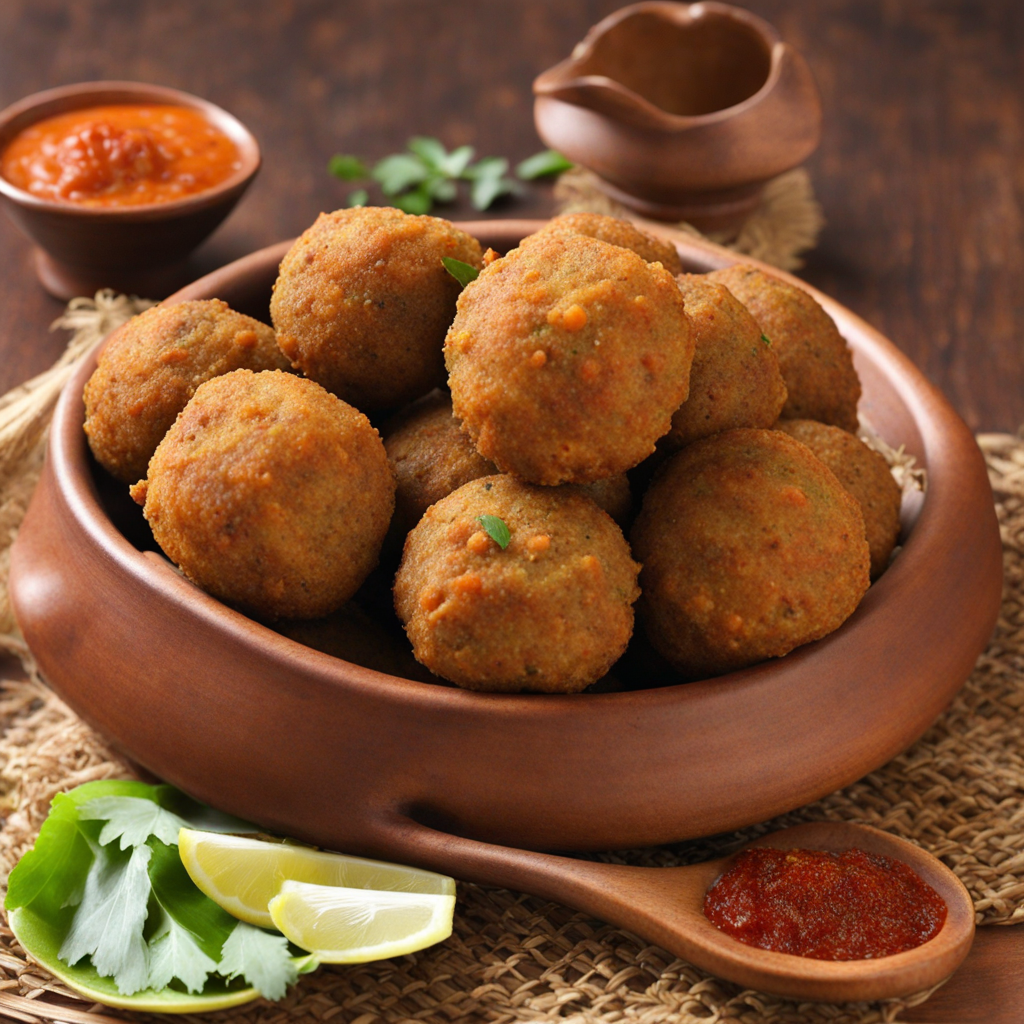Biriyani
Biriyani from Tanzania is a vibrant and aromatic dish that showcases the diverse culinary influences of the region, blending African, Indian, and Arab flavors into a delightful experience. This rice-based dish is typically prepared with fragrant basmati rice, marinated meat—often chicken, beef, or goat—and a medley of spices that can include cardamom, cloves, cinnamon, and cumin. The marination process infuses the meat with deep flavors, while the cooking technique allows the spices to permeate the rice, creating a rich tapestry of taste that is both hearty and comforting. One of the standout features of Tanzanian Biriyani is its use of coconut milk, which lends a creamy texture and a subtle sweetness to the dish. This ingredient elevates the flavor profile, making it distinct from other regional variations. The cooking method often involves layering the marinated meat and partially cooked rice, allowing the steam to meld the flavors together beautifully. Garnished with fried onions, boiled eggs, and fresh herbs like cilantro or mint, each serving is a feast for both the eyes and the palate. Serving Tanzanian Biriyani is often a communal affair, reflecting the culture of sharing and celebration. It is typically accompanied by side dishes such as kachumbari (a fresh tomato and onion salad) or a spicy chili sauce, which add a refreshing contrast to the rich flavors of the biriyani. Whether enjoyed at a family gathering or a local eatery, each bite of Tanzanian Biriyani invites you to explore the deep cultural roots and culinary artistry that make this dish a beloved staple in Tanzanian cuisine.
How It Became This Dish
The Rich History of Biryani in Tanzania Biryani, a dish synonymous with festivity and communal celebration, has traversed continents and cultures to become one of the most beloved culinary treasures of the world. While its roots lie in South Asian cuisine, particularly in India and Persia, the adaptation of biryani in Tanzania tells a compelling story of cultural exchange, adaptation, and culinary evolution that reflects the country’s rich historical tapestry. #### Origins The origins of biryani can be traced back to the Persian word ‘birian’, which means ‘fried before cooking’. It is believed that the dish was brought to the Indian subcontinent by the Mughals in the 16th century. The Mughal emperors, known for their sumptuous feasts, introduced elaborate cooking techniques and a variety of spices that would ultimately define Indian biryani. Over time, the dish evolved, incorporating local ingredients and flavors, leading to numerous regional variations across India and neighboring countries. The introduction of biryani to Tanzania is closely linked to the Indian Ocean trade networks, which connected East Africa and the Indian subcontinent for centuries. As traders and settlers from India established themselves on the East African coast, particularly in Zanzibar and Dar es Salaam, they brought with them not only spices and textiles but also their culinary traditions. The spice trade played a crucial role in this exchange, with cloves, cinnamon, and nutmeg becoming staples in Tanzanian cuisine. #### Cultural Significance In Tanzania, biryani has transcended its status as mere food to become a symbol of identity, celebration, and cultural fusion. The Swahili Coast, where Tanzania is located, has a rich history of interaction between African, Arab, and Indian cultures. This melting pot is vividly reflected in the flavors and preparation of Tanzanian biryani. Biryanis in Tanzania are often served during significant occasions such as weddings, religious festivals, and family gatherings. The dish is not just a meal; it embodies hospitality and community. The preparation of biryani is often a communal effort, bringing families and friends together to share in the cooking process. This collaborative spirit is integral to Tanzanian culture, where food is an essential element of social bonding. Tanzanian biryani is distinct from its South Asian counterparts, showcasing local ingredients and cooking methods. The use of coconut milk, a staple in coastal cuisine, adds a rich creaminess to the dish, while the inclusion of fresh herbs like coriander and mint enhances its aromatic profile. Additionally, the use of meats such as goat, chicken, or beef reflects local dietary preferences, often marinated with a blend of spices that may include cardamom, cloves, and cumin, along with a touch of heat from chili peppers. #### Development Over Time As Tanzania navigated through colonialism and independence, its culinary landscape continued to evolve. The British colonial presence introduced new ingredients and cooking techniques, subtly influencing the preparation of biryani. The period post-independence saw a resurgence of interest in traditional cuisines, as Tanzanians sought to reclaim and celebrate their culinary heritage amidst global influences. In the late 20th century, the diaspora of Tanzanian Indians, many of whom migrated to Western countries for better opportunities, became ambassadors of Tanzanian biryani. They introduced this dish to new audiences, showcasing its unique flavors and cultural significance. Restaurants serving Tanzanian cuisine began to emerge in cities like London, Toronto, and New York, creating a space for biryani to be appreciated beyond its geographical origins. The preparation of biryani in Tanzania has also adapted to contemporary culinary trends. While traditional methods continue to be cherished, modern variations have emerged, including vegetarian versions that cater to changing dietary preferences. Chefs and home cooks alike experiment with fusion biryanis that incorporate local ingredients alongside traditional spices, reflecting Tanzania’s dynamic and evolving culinary identity. #### Regional Variations In Tanzania, biryani varies significantly from one region to another, showcasing local ingredients and traditions. The coastal regions, particularly Zanzibar, are known for their exquisite seafood biryanis, which incorporate fresh fish and prawns, enhanced with the island's renowned spices. Zanzibar biryani often features a rich blend of flavors, with the addition of saffron and dried fruits, making it a luxurious and aromatic dish. In mainland Tanzania, particularly in Dar es Salaam and other urban areas, chicken and beef biryanis are more common. Here, the dish might be served with a side of kachumbari (a fresh tomato and onion salad) or a tangy pickle, enhancing the overall dining experience. Street food vendors also play a crucial role in keeping the biryani tradition alive, offering affordable and delicious versions that attract locals and tourists alike. #### The Modern Era In the 21st century, biryani has solidified its status as a beloved dish in Tanzania, celebrated in homes, restaurants, and at public events. Food festivals and cultural gatherings often feature biryani as a centerpiece, highlighting its importance in Tanzanian culinary traditions. Social media has also played a role in popularizing biryani, with food bloggers and influencers showcasing their unique takes on the dish, further inspiring innovation and creativity in its preparation. The global appreciation of Tanzanian biryani continues to grow, with chefs and food enthusiasts recognizing it as a unique expression of the country's rich cultural heritage. As people seek authentic experiences in their culinary explorations, Tanzanian biryani stands out as a testament to the island's history, culture, and the harmonious blend of flavors that define its cuisine. #### Conclusion The history of biryani in Tanzania is a fascinating narrative of migration, cultural exchange, and culinary adaptation. From its Persian origins to its establishment as a cherished dish on the Swahili Coast, biryani exemplifies how food can transcend borders and bring people together. It is more than just a meal; it is a symbol of heritage, community, and the enduring legacy of the interactions that have shaped Tanzanian culture over centuries. Today, as Tanzanians continue to celebrate and innovate their biryani traditions, they honor their past while embracing a vibrant culinary future.
You may like
Discover local flavors from Tanzania







